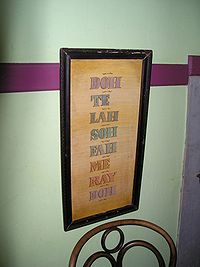Tonic sol-fa
Tonic sol-fa is the name of a teaching method for singing lessons in schools, which was propagated by Reverend John Curwen from 1842 . The teaching method based on the Norwich sol-fa of the educator Sarah Glover uses the tone syllables of the solmization , special hand signals and a rhythm language .
In order to make the tonic-sol-fa system known, Curwen founded the Tonic Sol-Fa Association ("Tonic-sol-fa-Society" or "Society of the Solfeggists ") around 1850 . Until the middle of the 20th century it was a very active association in Great Britain , which was dedicated to the pedagogical methods of music lessons with a focus on a cappella singing.
1841 learned Reverend John Curwen in Norwich that on the Solmisation based Norwich sol-fa of the music teacher Sarah Glover know. Enthusiastic about this system, Curwen worked all his life to improve and develop this learning system. Familiar with his father's life's work at an early age, John Spencer Curwen continued his work after his father's death.
Around 1025, Guido von Arezzo developed a syllable system that made melodies easier to learn. (For his music-making practice with boys he also mentally transferred this to the limbs and fingertips of his hand ( Guidonic hand )). Building on this, Sarah Glover began to develop her own system of solmization about 800 years later. Thanks to Curwen's efforts, this learning system was able to prevail, and until about 1930/35 English schools were taught according to the tonic-sol-fa system.
Tonic sol-fa found many followers, but was exposed to many changes. Agnes Hundoegger adopted the essential ideas of Curwen in her tonic-do teaching, and Zoltán Kodály also developed the tonic-sol-fa system with his Kodály method . In Germany, many ideas of tonic sol-fa were reflected in the teachings of Theodor Warner and Kurt Sydow .
The mouthpiece of the Tonic Sol-Fa Association was the magazine The Tonic Sol-Fa Reporter from 1851 , which Reverend Curven also founded. Since 1974 the Curwen Institute in London has been working very successfully to further develop the New Curwen Method .
Report by Hermann von Helmholtz, 1864
Helmholtz , an ardent advocate of pure intonation , reported in his doctrine of tone sensations as the physiological basis for the theory of music, also on the "Society of Solfeggists", which in 1862 already had 150,000 members. This society used the tonic-sol-fa method and consequently a syllabary (Do Re Mi Fa So La Ti Do) instead of musical notation, with Do always designating the tonic. When the tonic changed through modulation, the syllable designation also changed; the note on which the change occurred was given two syllables, the first and the second key. The intonation was always in relation to the tonic. When changing from C major to G Major as the A of G-Dur was purely voiced to the tonic G, in comparison with C-Dur ie a syntonic point higher.
Helmholtz heard 40 children between the ages of eight and twelve in a London elementary school, whose intonational purity astonished him. He pointed out that every year the London schools and solfeggists give a concert with 2,000 to 3,000 children's voices in the Crystal Palace in Sydenham, which makes the best impression on the listener due to its melodious sound and precision of execution.
literature
Monographs
- John Curwen: Grammar of Vocal Music on the Tonic Sol-Fa Method. Boethius Press, 1985, ISBN 0-86314-043-2
- John Curwen: Tonic Sol-Fa . Novello, London, 1878
- John S. Curwen: School Music Abroad . Boethius Pr., Kilkenny 1985, ISBN 0-86314-046-7 (Classic texts in music education, Volume 15)
- Hermann von Helmholtz: The theory of tone sensations as a physiological basis for the theory of music . Vieweg, Braunschweig 1863, reprint: Minerva-Verlag, Frankfurt / Main 1981, ISBN 3-8102-0715-2 Excerpt
- Sarah A. Glover: Scheme for Rendering Psalmody Congregational . Boethius Press, Kilkenny 1982, ISBN 0-86314-032-7 ( Classic texts in music education , Volume 5)
- Bettina Gratzki: The pure intonation in choral singing . Publishing house for systematic musicology, Bonn 1993 ( excerpt )
Magazines
- The Tonic Sol-Fa Reporter and Magazine of Vocal Music for the People , Ward, London, 1851 ff.
Individual evidence
- ↑ For the spelling of Tonic sol-fa and Tonic Sol-Fa Association cf. z. B. The following book description on copak.ac.uk and Curwen, John . In: Encyclopædia Britannica . 11th edition. tape 7 : Constantine Pavlovich - Demidov . London 1910, p. 664 (English, full text [ Wikisource ]).
